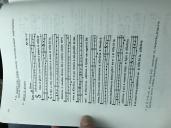Carmelite and Premonstratensian Easter Sunday Vespers?
-
Does anyone have Vespers for Easter Sunday from the Premonstratensian and Carmelite Uses? If so, would you please share? Thanks!!
-
Anyone?
-
MusicaSacra has a number of Carmelite books HERE, but you must know about that already.
-
Thanks, Jonathan, but I’m specifically looking for Easter Sunday Vespers, and those only have the Proper Offices/Masses. Great resources, though!
-
I’ve obtained a copy of the Thesaurus liturgicae Praemonstratensis, which has the baptismal Paschal Vespers adapted to the OF. Excuse the crude pictures. I was in a hurry. I’ll scan and make a pdf this evening.

 98E7F061-898D-47C3-BF42-DEE7B975ABED.jpeg4032 x 3024 - 3M
98E7F061-898D-47C3-BF42-DEE7B975ABED.jpeg4032 x 3024 - 3M
 B134F75C-6607-40BF-81D9-FD90CF87AF52.jpeg4032 x 3024 - 3M
B134F75C-6607-40BF-81D9-FD90CF87AF52.jpeg4032 x 3024 - 3M
 6206A5EF-E873-4080-96AF-515396C6CF34.jpeg2939 x 3921 - 2M
6206A5EF-E873-4080-96AF-515396C6CF34.jpeg2939 x 3921 - 2M
 F1EC6775-6B79-4E55-8F23-489494369416.jpeg2764 x 3690 - 2M
F1EC6775-6B79-4E55-8F23-489494369416.jpeg2764 x 3690 - 2M
 1AD34596-D465-43AD-BA7A-289FDD1BE5B4.jpeg4032 x 3024 - 2M
1AD34596-D465-43AD-BA7A-289FDD1BE5B4.jpeg4032 x 3024 - 2M
 93EBC2A1-8014-4901-94F5-C379DCE340C4.jpeg4032 x 3024 - 2M
93EBC2A1-8014-4901-94F5-C379DCE340C4.jpeg4032 x 3024 - 2M
 2A24EA4C-6D07-44A7-80C3-8DF923F38161.jpeg2780 x 3706 - 2M
2A24EA4C-6D07-44A7-80C3-8DF923F38161.jpeg2780 x 3706 - 2M
 89314329-B12E-42AE-91EC-1B9A3F8A4557.jpeg3024 x 4032 - 2M
89314329-B12E-42AE-91EC-1B9A3F8A4557.jpeg3024 x 4032 - 2M
 E6749A06-B11E-4FAA-A03D-DD1F3ADB9072.jpeg4032 x 3024 - 2M
E6749A06-B11E-4FAA-A03D-DD1F3ADB9072.jpeg4032 x 3024 - 2M
 5EB6976E-D90F-4525-AEC6-44F031AA17AC.jpeg4032 x 3024 - 2M
5EB6976E-D90F-4525-AEC6-44F031AA17AC.jpeg4032 x 3024 - 2M
 E6D4DE49-1D3F-49E9-894C-181AF85F3EBF.jpeg3024 x 4032 - 2M
E6D4DE49-1D3F-49E9-894C-181AF85F3EBF.jpeg3024 x 4032 - 2M
 612E07C8-3F3E-40E4-B125-C845F3EAE23E.jpeg3024 x 4032 - 2M
612E07C8-3F3E-40E4-B125-C845F3EAE23E.jpeg3024 x 4032 - 2M
 6427C089-2A6C-4377-BB9E-A2489ED8F6E6.jpeg3024 x 4032 - 2M
6427C089-2A6C-4377-BB9E-A2489ED8F6E6.jpeg3024 x 4032 - 2M -
Here’s the Old Roman schema:
At the ninth canonical hour (hora nona), the bishops, presbyters, deacons and the schola cantorum gather in the Lateran Basilica (in ecclesia maiore). Having arrived at the place called the Crucifix, they sing the invocation Kyrie eleison as they process to the altar. Then the deacons go up the podium, while the bishops and presbyters take their places in the presbyterium. After the Kyrie eleison, they sing the antiphon Alleluia, followed by the psalm Dixit dominus domino meo (Psalm 109). This is followed by Psalm 110 (Confitebor tibi), likewise introduced by the antiphon Alleluia. After the psalm and the alleluiatic antiphon, they sing the verses Dominus regnavit, decore induit; Parata sedes tua, Deus; and Elevaverunt flumina, domine (Cf. Ps 93). Then comes Alleluia with Psalm 111 (Beatus vir), followed by alleluiatic verses Pascha nostrum and Aepulemur, after which comes the gospel antiphon (in evangelio antiphona) executed by the archdeacon: Scio quod Iesum quaeritis crucifixum surrexit alleluia, to which all respond: Iesum quem quaeris non est hic sed surrexit recordare qualiter locutus sit vobis dum adhuc in Galilea esset alleluia. After the archdeacon has executed the antiphon, the priest says a prayer.
From the altar of the main church, the procession descends to the baptismal font, singing the antiphon In die resurrectionis meae, dicit Dominus, alleluia, congregabo gentes et colligam regna et effundam super
vos aquam mundam, alleluia. At the baptistery, the congregation sings the following: Alleluia, Psalm 112 (Laudate pueri), and alleluiatic verses in Greek (based on Ps 93); the gospel antiphon Venite et videte locum ubi positus erat Dominus alleluia is done by a second deacon, followed by a prayer said by a priest.
The procession forms again and heads to the oratory (ad sanctum Andream ad crucem) while singing the antiphon Vidi aquam egredientem de templo a latere dextro alleluia et omnes ad quos pervenit aqua ista salvi facti sunt alleluia alleluia. Dilexi quoniam exaudiet Dominus (Ez 47; Ps 116). At the oratory, they sing the alleluiatic antiphon, followed by Psalm 113 (In exitu Israel), then Alleluia, followed by alleluiatic verses Venite exultemus domino and Preoccupemus faciem eius (Cf. Ps 95). This is followed by the gospel antiphon Cito euntes dicite discipulis eius et Petro quia surrexit dominus, again executed by a deacon, after which the priest says a prayer. Vespers end here, and the ordo (OR XXX) informs us that this liturgy was repeated throughout the Easter octave, up to Low Sunday: [Haec] ratio per totam [h]ebdomadam servabitur usque in dominica albas. -
This Norbertine OF version is basically the same as the Roman OF with the antiphons replaced by Alleluias and the addition of the Gradual/Alleluia/Responsory, 2 extra Collects, another Lesson, Vidi aquam, and a different Magnificat.
Welcome to the MusicaSacra Forum!
To participate in the discussions on Catholic church music, sign in or register as a forum member, The forum is a project of the Church Music Association of America.
Categories
- All Discussions21,108
- General Music Discussion8,218
- Job Openings197
- Management of Music Programs850
- Choral Matters533
- Church Documents and Rubrics524
- CMAA Notes302
- Events716
- For Newcomers: Read First26
- Sacred Polyphony546
- Hymnody872
- Gregorian Chant: General2,698
- ↳ Graduale Romanum and Liber Usualis368
- ↳ Graduale Simplex60
- ↳ Semiology63
- Vernacular Plainsong696
- Anglican Use and Anglican Chant68
- Organ, Other Instruments and Repertoire435
- New Composition/Works in Progress1,291
- Recordings231
- Music for Hispanic Ministry159
- Music Education: Children211
- Music Education: General222
- News Items245
- Positions Wanted2
- General Discussion: Catholicism739
- Amusements177
- General Discussion1,033
- Opinions117


